国际贸易实务 Chapter2
- 格式:ppt
- 大小:1.22 MB
- 文档页数:69
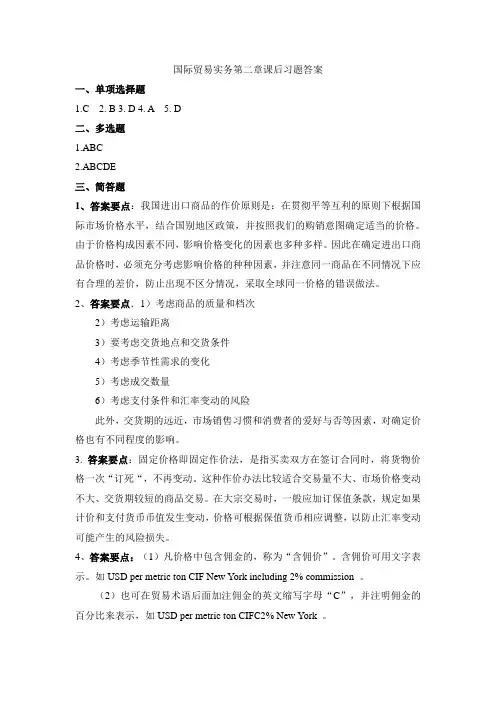
国际贸易实务第二章课后习题答案一、单项选择题1.C2. B3. D4. A5. D二、多选题1.ABC2.ABCDE三、简答题1、答案要点:我国进出口商品的作价原则是:在贯彻平等互利的原则下根据国际市场价格水平,结合国别地区政策,并按照我们的购销意图确定适当的价格。
由于价格构成因素不同,影响价格变化的因素也多种多样。
因此在确定进出口商品价格时,必须充分考虑影响价格的种种因素,并注意同一商品在不同情况下应有合理的差价,防止出现不区分情况,采取全球同一价格的错误做法。
2、答案要点.1)考虑商品的质量和档次2)考虑运输距离3)要考虑交货地点和交货条件4)考虑季节性需求的变化5)考虑成交数量6)考虑支付条件和汇率变动的风险此外,交货期的远近,市场销售习惯和消费者的爱好与否等因素,对确定价格也有不同程度的影响。
3.答案要点:固定价格即固定作价法,是指买卖双方在签订合同时,将货物价格一次“订死“,不再变动。
这种作价办法比较适合交易量不大、市场价格变动不大、交货期较短的商品交易。
在大宗交易时,一般应加订保值条款,规定如果计价和支付货币币值发生变动,价格可根据保值货币相应调整,以防止汇率变动可能产生的风险损失。
4、答案要点:(1)凡价格中包含佣金的,称为“含佣价”。
含佣价可用文字表示。
如USD per metric ton CIF New York including 2% commission 。
(2)也可在贸易术语后面加注佣金的英文缩写字母“C”,并注明佣金的百分比来表示,如USD per metric ton CIFC2% New York 。
(3)明佣的表示方法一般是在价格之后加列一定百分比的佣金率,如USD27.50 per piece CIFC5 New York ,这里的C5指5%commission ,即佣金率。
(4)除用百分比表示外,也可以用绝对数来表示,如“每公吨付佣金25美元”。
如中间商为了从买卖双方获取“双头佣金”或为了逃税,有时要求在合同中不规定佣金,而另按双方暗中达成的协议支付。
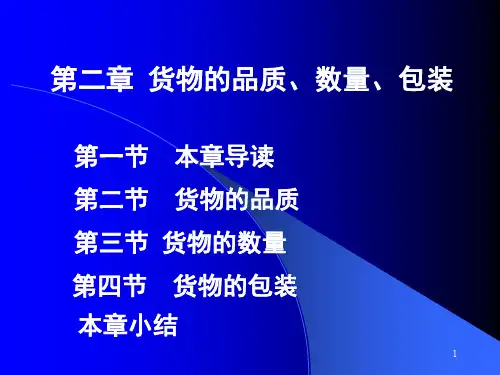

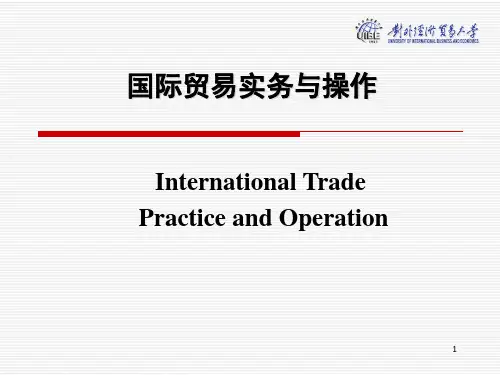
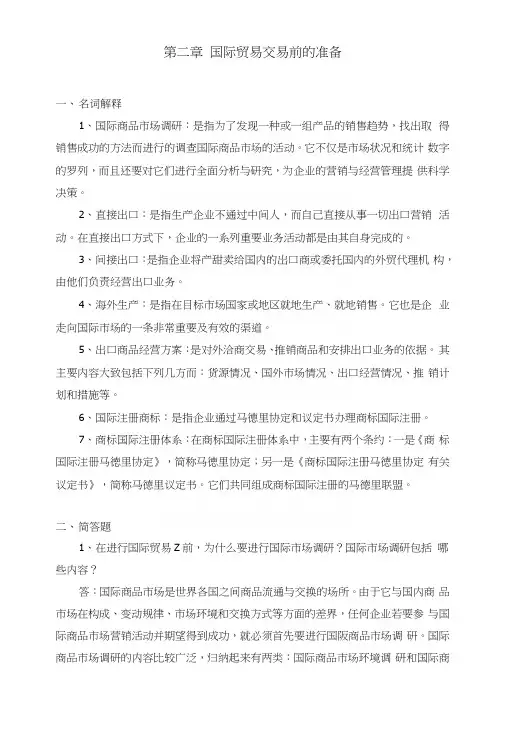
第二章国际贸易交易前的准备一、名词解释1、国际商品市场调研:是指为了发现一种或一组产品的销售趋势,找出取得销售成功的方法而进行的调查国际商品市场的活动。
它不仅是市场状况和统计数字的罗列,而且还要对它们进行全面分析与研究,为企业的营销与经营管理提供科学决策。
2、直接出口:是指生产企业不通过中间人,而自己直接从事一切出口营销活动。
在直接出口方式下,企业的一系列重要业务活动都是由其自身完成的。
3、间接出口:是指企业将产甜卖给国内的岀口商或委托国内的外贸代理机构,由他们负责经营出口业务。
4、海外生产:是指在目标市场国家或地区就地生产、就地销售。
它也是企业走向国际市场的一条非常重要及有效的渠道。
5、出口商品经营方案:是对外洽商交易、推销商品和安排出口业务的依据。
其主要内容大致包括下列几方而:货源情况、国外市场情况、出口经营情况、推销计划和措施等。
6、国际注册商标:是指企业通过马德里协定和议定书办理商标国际注册。
7、商标国际注册体系:在商标国际注册体系中,主要有两个条约:一是《商标国际注册马徳里协定》,简称马徳里协定;另一是《商标国际注册马徳里协定有关议定书》,简称马德里议定书。
它们共同组成商标国际注册的马德里联盟。
二、简答题1、在进行国际贸易Z前,为什么要进行国际市场调研?国际市场调研包括哪些内容?答:国际商品市场是世界各国之间商品流通与交换的场所。
由于它与国内商品市场在构成、变动规律、市场环境和交换方式等方面的差界,任何企业若要参与国际商品市场营销活动并期望得到成功,就必须首先要进行国阪商品市场调研。
国际商品市场调研的内容比较广泛,归纳起来有两类:国际商品市场环境调研和国际商品市场行情调研。
国际商品市场环境调研通常包括政治环境、经济环境、文化环境、地理环境以及竞争环境等的调研;国际商品市场行情调研的内容主要包括市场营销活动的各个方面。
它概括有以下几方面:出口商品生产的调研、出口商品消费调研、国际商品市场需求潜力的调研、商品价格调研、营销方式调研和商品销售渠道调研等。

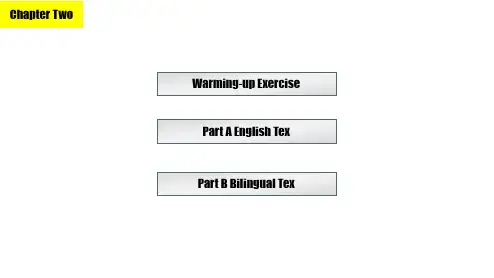
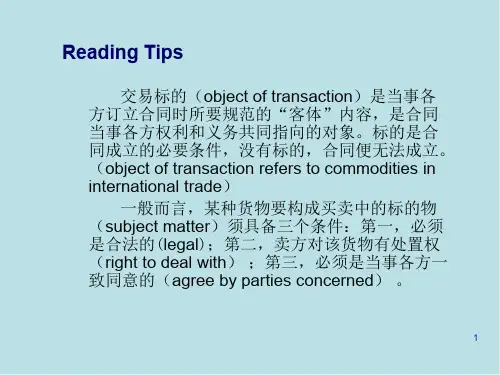
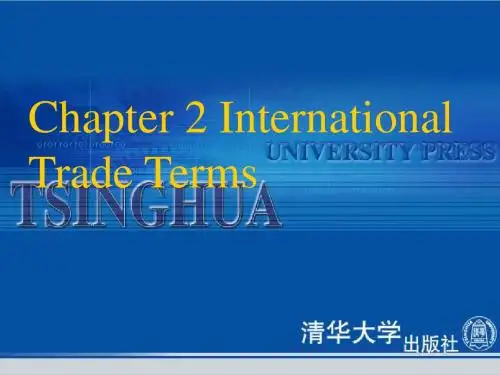
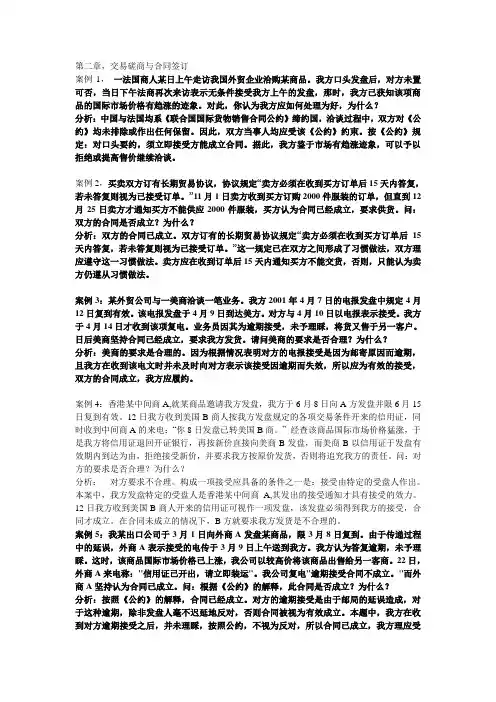
第二章,交易磋商与合同签订案例1,一法国商人某日上午走访我国外贸企业洽购某商品。
我方口头发盘后,对方未置可否,当日下午法商再次来访表示无条件接受我方上午的发盘,那时,我方已获知该项商品的国际市场价格有趋涨的迹象。
对此,你认为我方应如何处理为好,为什么?分析:中国与法国均系《联合国国际货物销售合同公约》缔约国,洽谈过程中,双方对《公约》均未排除或作出任何保留。
因此,双方当事人均应受该《公约》约束。
按《公约》规定:对口头要约,须立即接受方能成立合同。
据此,我方鉴于市场有趋涨迹象,可以予以拒绝或提高售价继续洽谈。
案例2,买卖双方订有长期贸易协议,协议规定“卖方必须在收到买方订单后15天内答复,若未答复则视为已接受订单。
”11月1日卖方收到买方订购2000件服装的订单,但直到12月25日卖方才通知买方不能供应2000件服装,买方认为合同已经成立,要求供货。
问:双方的合同是否成立?为什么?分析:双方的合同已成立。
双方订有的长期贸易协议规定“卖方必须在收到买方订单后15天内答复,若未答复则视为已接受订单。
”这一规定已在双方之间形成了习惯做法,双方理应遵守这一习惯做法。
卖方应在收到订单后15天内通知买方不能交货,否则,只能认为卖方仍遵从习惯做法。
案例3:某外贸公司与一美商洽谈一笔业务。
我方2001年4月7日的电报发盘中规定4月12日复到有效。
该电报发盘于4月9日到达美方。
对方与4月10日以电报表示接受。
我方于4月14日才收到该项复电。
业务员因其为逾期接受,未予理睬,将货又售于另一客户。
日后美商坚持合同已经成立,要求我方发货。
请问美商的要求是否合理?为什么?分析:美商的要求是合理的。
因为根据情况表明对方的电报接受是因为邮寄原因而逾期,且我方在收到该电文时并未及时向对方表示该接受因逾期而失效,所以应为有效的接受,双方的合同成立,我方应履约。
案例4:香港某中间商A,就某商品邀请我方发盘,我方于6月8日向A方发盘并限6月15日复到有效。
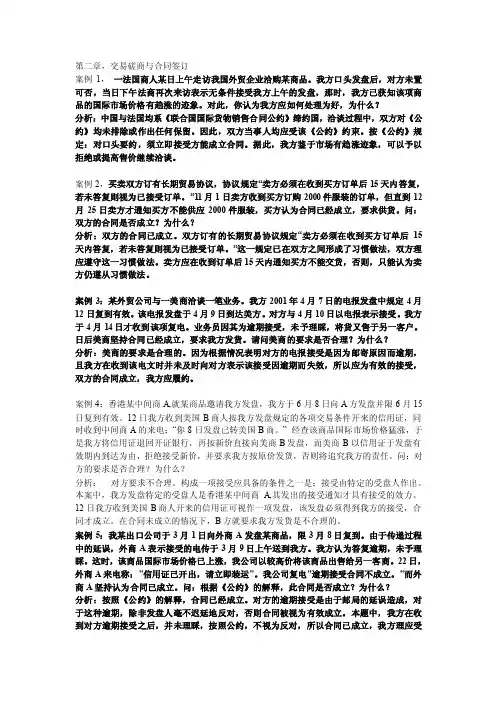
第二章,交易磋商与合同签订案例1,一法国商人某日上午走访我国外贸企业洽购某商品。
我方口头发盘后,对方未置可否,当日下午法商再次来访表示无条件接受我方上午的发盘,那时,我方已获知该项商品的国际市场价格有趋涨的迹象。
对此,你认为我方应如何处理为好,为什么?分析:中国与法国均系《联合国国际货物销售合同公约》缔约国,洽谈过程中,双方对《公约》均未排除或作出任何保留。
因此,双方当事人均应受该《公约》约束。
按《公约》规定:对口头要约,须立即接受方能成立合同。
据此,我方鉴于市场有趋涨迹象,可以予以拒绝或提高售价继续洽谈。
案例2,买卖双方订有长期贸易协议,协议规定“卖方必须在收到买方订单后15天内答复,若未答复则视为已接受订单。
”11月1日卖方收到买方订购2000件服装的订单,但直到12月25日卖方才通知买方不能供应2000件服装,买方认为合同已经成立,要求供货。
问:双方的合同是否成立?为什么?分析:双方的合同已成立。
双方订有的长期贸易协议规定“卖方必须在收到买方订单后15天内答复,若未答复则视为已接受订单。
”这一规定已在双方之间形成了习惯做法,双方理应遵守这一习惯做法。
卖方应在收到订单后15天内通知买方不能交货,否则,只能认为卖方仍遵从习惯做法。
案例3:某外贸公司与一美商洽谈一笔业务。
我方2001年4月7日的电报发盘中规定4月12日复到有效。
该电报发盘于4月9日到达美方。
对方与4月10日以电报表示接受。
我方于4月14日才收到该项复电。
业务员因其为逾期接受,未予理睬,将货又售于另一客户。
日后美商坚持合同已经成立,要求我方发货。
请问美商的要求是否合理?为什么?分析:美商的要求是合理的。
因为根据情况表明对方的电报接受是因为邮寄原因而逾期,且我方在收到该电文时并未及时向对方表示该接受因逾期而失效,所以应为有效的接受,双方的合同成立,我方应履约。
案例4:香港某中间商A,就某商品邀请我方发盘,我方于6月8日向A方发盘并限6月15日复到有效。
国际贸易实务英文版第二版课后习题答案Chapter 2 International Trade Terms I. Multiple choices II. True or false statements 1 B T 2 C T 3 A F 4 C F 5 C T 6 D F 7 A F 8 B F 9 C F 10 D T III. Explain the following terms 1. shipment contractShipment contract is a contract using an Incoterm which indicates that the delivery happens at the time or before the time of shipment. 2. symbolic deliverySymbolic delivery is a delivery situation in which when the sellerdelivers the buyer does not physically receive the goods. This kind ofdelivery is proved by the submission of transport document by the seller to the buyer.3. arrival contractArrival contract means a contract using an Incoterm which indicates that the delivery happens when the goods arrive at the destination. 4. actual deliveryActual delivery refers to a delivery situation in which when the seller delivers the buyer does physically receive the goods. IV. Short questions1. Who pays for loading for shipment under FOB ? The seller.2. Who pays for unloading under CIF? The buyer.3. Compare and contrast FOB, CFR and CIF?Similarities: a. The seller's risk will be transferred to the buyer when the goods are loaded on board, b. The seller is responsible for export customs formalities while the buyer is responsible for import customs formalities, c. The buyer is responsible for unloading the goods at the port of destination, d. All three terms can only be used for waterway transportation.Differences: a. FOB requires the buyer to arrange and pay for the ocean transportation; CFR requires the seller to arrange and pay for the ocean transportation; CIF requires the seller to arrange and pay for the ocean transportation and insurance against the buyer's risk.4. What are the two types of trade terms concerning the transfer of risks?Shipment contract terms vs. arrival contract terms. Under shipment contract terms the seller's risk will be transferred to the buyer before the goods depart from the place/port of shipment. Under arrival contract terms the seller will bear the risk of the goods until the goods arrive at the destination. 5. What are the differences and similarities between CPT and CFR?Major similarities: a. The seller should contract and pay for the major carriage. b. The seller is not taking the risk of loss of or damage to the goods during the transportation.Difference: a. CPT is applicable to any kind of transportation mode while CFR is only used for waterway transport, b. Under CPT the seller's risk will be transferred to the buyer when the goods are handed over to the firstcarrier nominated by the seller. Under CFR the seller's risk will be transferred when the goods are loaded on board the vessel.6. What are the differences and similarities between CIP and CIF?Major similarities: a. The seller should contract and pay for the major carriage. b. The seller is not taking the risk of loss of or damage to the goods during the transportation, c. The seller must obtain insurance against the buyer's risk.1Difference: a. CPT is applicable to any kind of transportation mode while CFR is only used for seaway or inland waterway transport, b. Under CPT the seller's risk will be transferred to the buyer when the goods are handed over to the first carrier nominated by the seller. Under CFR the seller's risk will be transferred when the goods are loaded on board the vessel.7. If you trade with an American, is the sales contract subject to Incoterms without any doubt? What should you do?No. The Revised American Foreign Trade Definitions 1941 is still in use, especially in the North American area. It has different interpretation about some trade terms. The traders should clarify the choice of rules before any further discussion.8. What are the most commonly used trade terms? FOB, CFR & CIF.9. Who is responsible for carrying out customs formalities for exports under an FOB contract?The seller. According to Incoterms 2021, except EXW and DDP these two terms, all the other eleven terms require the seller to handle the export customs formalities, while the buyer the import customs formalities. 10. If a Chinese trader signs an FOB Hamburg contract, is he exporting or importing?Importing. FOB should be used with a \Chinese trader's perspective, he is importing. V. Case studies1. An FOB contract stipulated \March 201 l, the seller contacted the buyer for shipment details. The buyer faxed \port for loading on 21 March. The vessel will depart on 22 March.\The seller sent the goods to the port accordingly. However the nominated vessel did not turn up and the goods had to be stored in the warehouse at the port. On the night of 21 March a fire happened in the warehouse area and part of the goods was damaged. When the vessel arrived two days later the seller and the buyer had an argument about the settlement of the loss. The seller required the buyer to bear the loss caused by the fire, but the buyer believed that the vessel arrived within the shipment period and the loss occurred before the seller delivered the goods therefore the seller should bear the loss. Please provide your solution.析:1)首先案例中提到货物发生了损失是由于货物存放在码头仓库期间发生火灾造成的。